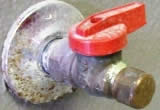Propane Gas Appliance Connections

Appliance service connections are the last line of delivery in a propane gas system. Propane users are familiar with gas flex lines and fittings used to connect gas appliances to an LP Gas system and the proper connections must be made for these appliances to operate safely. These appliance connections should be inspected by licensed service personnel such as an appliance technician or propane company representative. Additionally, propane appliances must be connected to gas plumbing by way of a valve. Appliances connected directly to building gas plumbing (without a gas valve) constitute illegal installations and can not be serviced.
Although appliance service connections are easy to replace, these important propane distribution valves and lines
should be protected against damage and properly installed to prevent accidents, harm or property damage. Only approved
materials and connections should be used in accordance with appliance manufacturer specifications and regulations set
out by NFPA 54.
* Important - Propane appliance valves and connections can be easily closed, disconnected or damaged if
accessible to pets or children. Precautions should be taken to minimize the threat to appliance connections or exposed
gas lines connecting these appliances to a propane piping system.
Approved LP Gas Appliance Valves

Propane valves that service appliances such as heaters are known as shut-off valves or cut-off valves and are easily seen protruding from the floor or wall. According to NFPA 54 3.8.2, all gas cut-off valves not servicing or connected to an appliance must be capped or plugged with a threaded gastight seal. The picture to the left illustrates a properly capped propane gas appliance valve. Additionally, all propane gas valves installed for servicing appliances are listed to be installed for the service and supply of one gas appliance. In other words, a propane water heater and propane furnace can not be supplied by one single valve. Each appliance is required to be serviced by it's own "dedicated" valve.
Dangerous LP Gas Appliance Valves

Appliances connected to unapproved propane gas valves constitute illegal installations and are extremely unsafe. Historically, gas hose was used indoors and was connected to a "push-on" type gas valve (pictured left). This type of valve is no longer approved (other than for laboratory use) based on the number of accidents involving these types of propane valves. Any appliance cut-off valve that is not approved for LP Gas use will render the entire propane gas system illegal and unfit for continued service until necessary repairs are made.
Propane Gas Flex Lines

Stationary propane appliances used indoors are required to be connected to LP Gas building piping systems with metallic piping, tubing and fittings. Most users recognize this type of connection as a flex line. Flex lines used in gas systems allow for the ease of appliance installation and flexibility if the equipment is moved. Over time, flex lines can become stressed if the appliance they are connected to is frequently moved and because of this, flex lines need to be periodically inspected. If the line has become cracked due to wear, it will need to be replaced as leaks can form on a cracked gas flex line.
